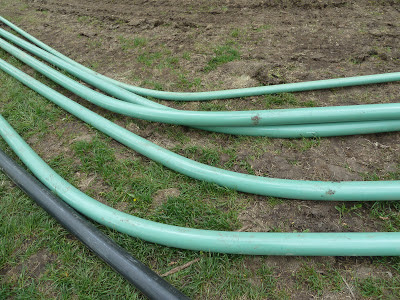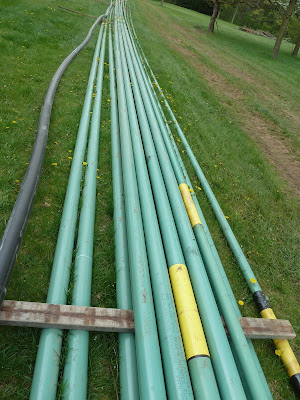After postponing the operations due to a soccer tournament (how nice of Savoy!), they continued to work on the pipeline today - and they started drilling for oil on the property of Stratton's Landscaping - as previously suspected by Victoria.
 Large Drilling Derrick on Stratton's. Location of Site on Map Below.
Large Drilling Derrick on Stratton's. Location of Site on Map Below.
Today's investigational journalism got us a home visit of the state police. Savoy had the driveway down to the disc golf area blocked off. However, nobody stopped us from walking down there.

I approached the new construction site at the end of the buried pipes down at the disc golf area - and was approached by a nice young man from the construction company to whom I talked before. He told me that I should not approach the construction site any closer, which I respected. The reasons given were liability issues. I took some more pictures, Amy and I talked a little more with the guy, who threw sticks for our dog. On our way back to the car, I was approached by a gray-haired - casually dressed guy, who I have seen around the Heritage drilling site before. (Edit: Jack Rokos is Savoy's Operations Manager). He told me he was from the oil company and ordered me quite aggressively to stay away from "his" construction site and I assured him that we will do so - and that we obeyed before and did not approach the site closer than about 100-200 yards. By the way, there were also disc golfers down there that were not approached by the oil and construction staff - and were not any further away...I wonder why we get a special treatment???


I tried to get some more information about the final drilling process to connect the pipelines and after confirming that drilling was done vertically and horizontally from up off Howell Highway and would reach exactly to the end of the buried pipes at the disc golf area, and that no clearing of the woods towards Beaver Creek would be necessary, he changed his mind and would not give out any other useful information. We assured him that we would stay away from the actual construction site and started walking down a beautiful, lush green path, that was heading towards the drilling noise from the new drilling site on Stratton's. The path did not really get us closer to make any pictures from public land and ended soon at a pretty deteriorated fence to private property, which we - as it is our principle - did not enter. During this walk in the woods we heart 2 bangs that sounded like small gas explosions (between 2 and 2:15 pm). In the favor of believing in the good of people, I was thinking that that's why we were asked to stay at a safe distance...

We went back to the car to see that now 3 cars were blocking the driveway down to the disc golf and model plane area. We drove away and wanted to see if we could get a better shot of the drilling rig on Stratton's from the Skating compound, when we realized that one of the three cars was following us. We did a loop around the old farm building on Heritage and went behind the truck that probably was send to follow us?


We went across the street to the skating ring and I took a few pictures of the rig (see above), when we realized a state police car pulling into Heritage Park - sure enough - we soon had two friendly officers in our apartment hallway at home - that wanted to follow up with us what was going on - while assuring us that no complaints were filed. They stated that Savoy leased the City Parks and would therefore have the right to limit - or completely forbid access to a public park during its operations - or for a prolonged time. They also warned us that our friendly dog could get into trouble when approaching workers - which was surely not a problem with today's worker, who threw Faith's stick for her.
All-in-all I do not know what I should make out of this day's occurrences.
I do certainly not believe that a lessee of mineral rights is authorized to shut down a public park - not even forbid access to areas beyond the immediate work area. As I stated before, I do not trespass on private property, especially if it is clearly marked as such - and I respected the "orders" of the worker and the oil company guy to stay at a save distance from the construction site, without the site being properly marked as such, or a clear statement in any ordinance stating to stay lets say 200 yards away from oil and gas operations...
I cannot shake the feeling off that Savoy - and a few beneficiaries of the oil boom in our city - are getting irritated and start to harass me and the investigational journalism that I try to develop. It began with the city police being called in when I showed a team of the Toledo Blade around. Again, we stayed off of clearly marked or obvious private properties - and no closeup pictures of persons were taken - beside mine, which I was OK with. I actually just received a harassing phone call of somebody, who obviously profits from the oil hysteria in Adrian - and did not like the pretty mallow article in the Toledo Blade...
If my humble careful writing and pictures are causing such inappropriate response - then there is maybe a reason why people get nervous - there is maybe really something they want to hide - and not bring to public notice?
Luckily, what I am doing is not depending on me alone and there are more people involved in this matter than can be easily threatened and silenced!
 Location of the new drilling operation. I hope the pipeline from that well will not also cross Beaver Creek to reach Witt Farm
Location of the new drilling operation. I hope the pipeline from that well will not also cross Beaver Creek to reach Witt Farm
Current wells around Witt Farm - check them out on your own at:
















































